Kingdom Animalia Clade Neodiapsida Rank Order | Class Reptilia Phylum Chordata | |
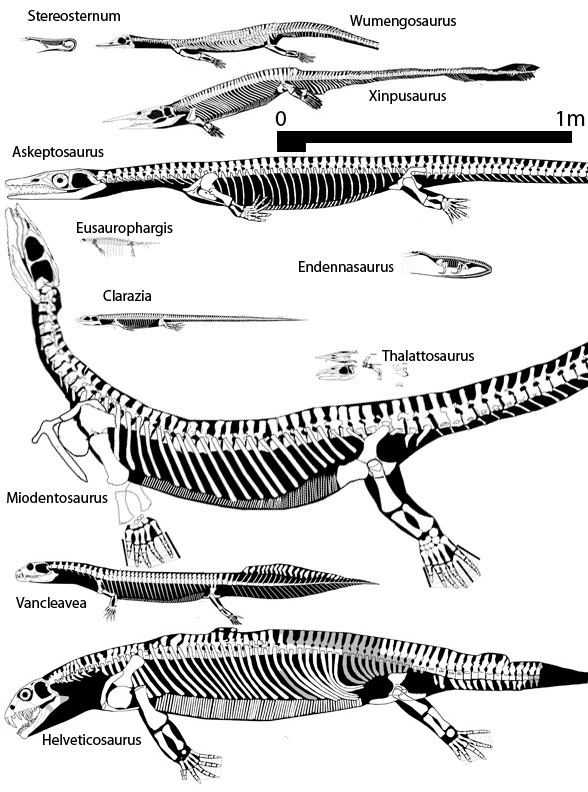 | ||
Similar Thalattosaurus, Xinpusaurus, Askeptosaurus, Placodont, Sauropterygia | ||
Thalattosaurs (meaning "ocean lizards") are a group of prehistoric marine reptiles that lived during the mid-late Triassic Period. Some species of thalattosaur grew to over 4 metres (13 feet) in length, including a long, flattened tail used in underwater propulsion. While they bore a superficial resemblance to lizards, the exact relationships of thalattosaurs is unknown; they are widely accepted as diapsids, but experts have variously placed them on the reptile family tree near ichthyosaurs, archosaurs, or Lepidosauromorpha (lizards and their relatives), or as basal neodiapsids.
Contents

Description
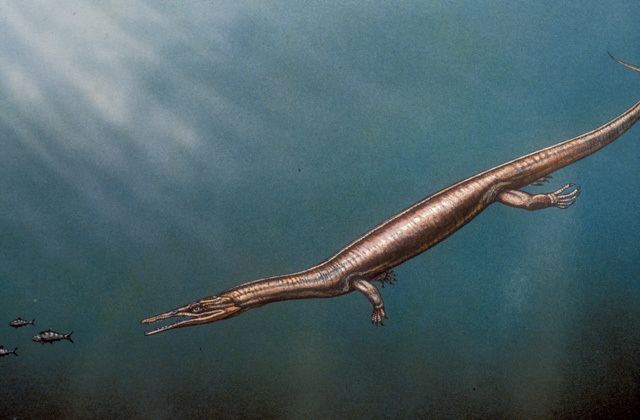
Thalattosaurs have moderate adaptations to marine lifestyles, including long, paddle-like tails and slender bodies. Primitive features of thalattosaurs include the many teeth covering the palate, single-headed ribs, and broad, plate-like coracoid bones. The most unusual features of thalattosaurs are their snouts. Members of one group, the Askeptosauroidea, have long, narrow, pointed skulls. The extended rostra at the end of the skull push back the nostrils so that they are positioned closer to the eye sockets. Most have small teeth, but one askeptosauroid, Endennasaurus, is entirely toothless. Members of a second group, Thalattosauroidea, have more distinctive downturned snouts. Clarazia and Thalattosaurus both have snouts that taper into a narrow tip. Most of the snout is straight, but premaxillae at the tip are downturned. Xinpusaurus also has downturned premaxillae, but the end of the maxillae are sharply upturned, forming a notch in the skull. In Hescheleria, Nectosaurus, and Paralonectes, the premaxillae are abruptly downturned at the end of the snout, nearly forming a right angle with the rest of the jaw. In these forms, the end of the snout is a toothy hook separated from the rest of the jaw by a space called a diastema.
History
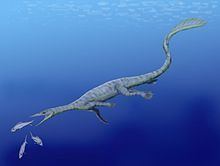
The Thalattosauria (and family Thalattosauridae) were named by American paleontologist John C. Merriam in 1904 for a distinctive group of marine reptiles, at the time containing only the first known species, Thalattosaurus. Merriam mentioned a jaw that was found from a Triassic deposit in California and noted similarities between it and the ichthyosaur Mixosaurus, assigning the material to the genus. More remains were uncovered from Shasta County in 1902 and 1903 by the University of California. These specimens were found in marine limestones alongside the bones of ichthyosaurs, fish scales, and mollusk shells. The holotype specimen of Thalattosaurus, the basis of Merriam's description of thalattosaurs, was found in four broken pieces separated by veins of rock. The rock was removed during preparation. In restoring the skull, Merriam considered the snout to be straight, like those of other reptiles. Round bone fragments near the limbs of Thalattosaurus were interpreted as phalanges, and the entire limb was considered to be a paddle. Later specimens with preserved limbs revealed that thalattosaurs retained functional digits.
Distribution

Thalattosaur fossils have been found in California, Nevada, and British Columbia. They are also present in Europe, with remains having been found from Switzerland, Austria, and Italy. More recently, thalattosaur fossils have been found in China.

A thalattosaur fossil (UAM:ES:23258) was found on the shoreline of a southeast Alaskan island in May, 2011. It included an exposed part of the tail found in calcareous shale in the intertidal zone. Several blocks containing the rest of the skeleton were sawed from the surrounding rock. Impressions of the bivalve Halobia were found around the skeleton. The thalattosaur lived in tropical waters surrounding a volcanic atoll that existed in the area during the Norian stage of the Late Triassic. A second thalattosaur fossil was found on the shoreline of south-central Alaska near Anchorage in late July, 2011.
Systematics
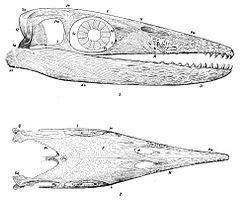
Thalattosaurs were first classified by Merriam as diaptosaurs, or primitive diapsids. He compared them to Rhynchocephalia, which includes the living tuatara. The classification of thalattosaurs has varied from study to study, especially since some paleontologists began including the askeptosaurids as true thalattosaurs. While some authors have placed the traditional thalattosaurs and the askeptosaurids within an expanded Order Thalattosauria, some cladistic definitions (see Phylogeny below) reserve the name Thalattosauria for a clade comprising the traditional thalattosaurs, and name the larger thalattosaur-askeptosaurid group Thalattosauriformes. In studies that use a more inclusive Thalattosauria, the name Thalattosauroidea has been used for the more exclusive thalattosaur group.
Taxonomy
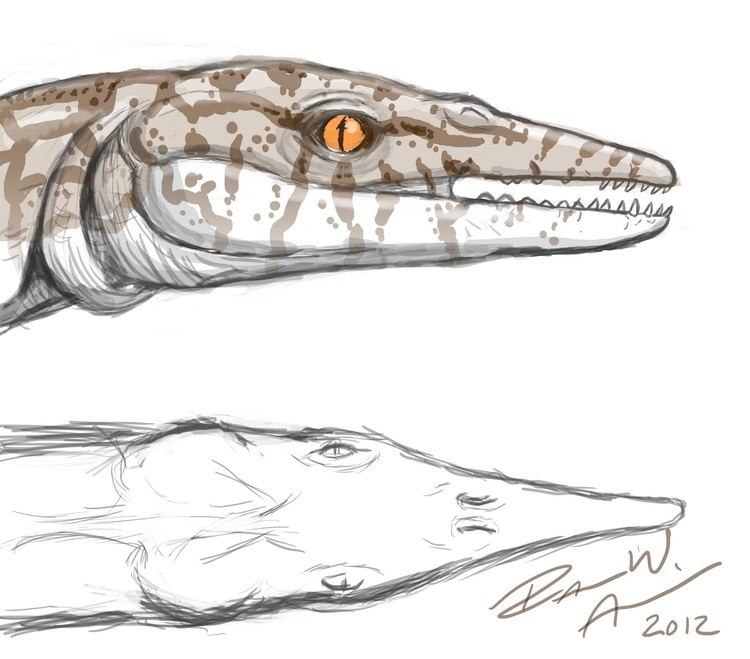
The taxonomy presented here includes genera listed in an online survey by Mikko Haaramo, with additional taxa added based on their referral in subsequent papers. Thalattosauria is used in its most inclusive sense after Cheng et al., 2007. Note that the family Thalattosauridae is paraphyletic, as it includes the direct ancestors of the family Claraziidae.
Phylogeny
While Thalattosauria has traditionally been used for the largest group containing all families of "thalattosaurs", several authors have recently used this name for what would otherwise be known as Thalattosauroidea, and used the clade Thalattosauriformes for the larger group. The phylogeny presented here again follows Haaramo (2004) and Wu et al. (2009).
